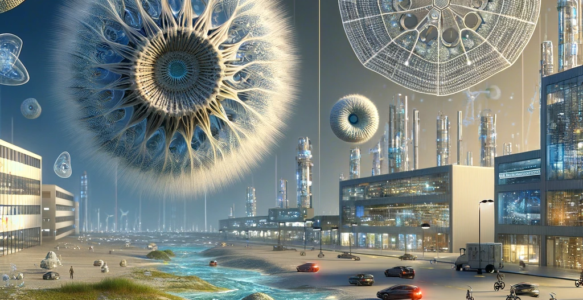
In the quest for sustainable and efficient engineering solutions, the microscopic world of diatoms offers a treasure trove of design principles. Diatoms, with their intricate and resilient silica shells, have inspired a groundbreaking study that reimagines surface stiffening techniques for lightweight engineering. This exploration into stress-adaptive structures, motivated by the remarkable morphologies of diatom frustules, opens up new avenues for addressing engineering challenges that demand enhanced stiffness without compromising on weight.
The Diatom Inspiration
Diatoms are microscopic algae renowned for their silicified frustules, which exhibit extraordinary mechanical properties and complex patterns. These natural architects have evolved highly optimized structures that provide protection and buoyancy, making them a focal point for biomimetic research. By mimicking the design strategies of diatom shells, researchers aim to develop lightweight, yet robust solutions that can adapt to varying stress conditions, a concept that stands to revolutionize engineering approaches across multiple disciplines.

(a) pattern A: stress-adaptive randomized comb distribution.
(b) pattern B: stress-adaptive morphed hexagon combs.
(c) pattern C: stress-adaptive morphed hexagon center points, with subsequent Voronoi application.
A New Approach to Engineering
The interdisciplinary study delves into the potential of diatom-inspired surface stiffeners, utilizing computer-aided design to generate lightweight structures optimized for bending stiffness. Through meticulous analysis and abstraction of diatom frustules’ morphological characteristics, the researchers crafted models that underwent mechanical behavior simulations under load-bearing conditions. This innovative strategy not only demonstrated a significant improvement in bending stiffness but also highlighted the versatility of biomimetic designs in engineering applications.


Unveiling the Potential
The investigation revealed that stress-adaptive structures inspired by diatoms could drastically reduce displacement, by up to 93%, compared to conventional engineering models with the same mass. This remarkable achievement underscores the efficiency of the biomimetic approach in enhancing structural stiffness while maintaining lightweight characteristics. Although traditional engineering methods might still be favored in specific scenarios, the diatom-inspired approach offers a promising solution for situations that require a dynamic response to varying stresses.
Beyond Conventional Boundaries
One of the most compelling aspects of this research is its successful automation, making the biomimetic approach applicable to non-planar surfaces and a wide range of boundary conditions. This adaptability not only showcases the method’s potential to cater to diverse engineering needs but also emphasizes the importance of interdisciplinary collaboration in pushing the boundaries of what’s possible in design and architecture.
The Future of Biomimetic Engineering

As we stand on the brink of a new era in engineering, inspired by the microscopic intricacies of nature, the study of diatom-inspired structures offers a glimpse into a future where design solutions are sustainable, efficient, and adaptable. The convergence of biology and engineering, facilitated by advanced computational tools, holds the promise of innovative solutions that are in harmony with the principles of nature. This exploration into diatom-inspired engineering is not just a testament to the ingenuity of nature but also a call to action for engineers, architects, and designers to look beyond conventional methods. By embracing the lessons from diatoms, we can create structures that are not only lightweight and strong but also capable of adapting to the ever-changing demands of the environment and society. In conclusion, the study “Stress-Adaptive Stiffening Structures Inspired by Diatoms: A Parametric Solution for Lightweight Surfaces” serves as a beacon of innovation, guiding us towards a future where the designs are inspired by the efficiency and resilience of natural systems. As we continue to explore the vast potential of biomimetics, the blueprint for sustainable and adaptable engineering solutions is being redrawn, inspired by the microscopic world of diatoms.
Learn More information link to: Biomimetics | Free Full-Text | Natural Frequencies of Diatom Shells: Alteration of Eigenfrequencies Using Structural Patterns Inspired by Diatoms (mdpi.com)

